- Quick Read
- Deep Read ( 6 Min. )
Monitor Daily Podcast
- Follow us:
- Apple Podcasts
- Spotify
- RSS Feed
- Download
TODAY’S INTRO
Universal hygge
 Mark Sappenfield
Mark Sappenfield
I love the Danish concept of hygge. I’m sure many of you have heard of it. Contributor Sam Laine Perfas talks about it today. In a word, it’s the “coziness” we feel being at home.
But I also love that Sam challenges us to expect more. That feeling of safety and radiant comfort should expand into more than candles and winter nights by the fire. In some ways, hygge is simply a measure of world progress – the product of a secure, balanced, meaningful life. We can help, not so much by seeking hygge, but by spreading it.
Share this article
Link copied.

Help fund Monitor journalism for $11/ month
Already a subscriber? Login

Monitor journalism changes lives because we open that too-small box that most people think they live in. We believe news can and should expand a sense of identity and possibility beyond narrow conventional expectations.
Our work isn't possible without your support.
In a Ukraine at war, the abnormal is the new normal
How has Lyman, a battered community in eastern Ukraine, endured two years of a war that never feels far away? Children need a secure routine. Services need to be restored. Yet everywhere, still, is uncertainty.

Lyman, a sprawling railway hub in eastern Ukraine, was occupied for four months by Russian troops, and then liberated in October 2022 during a sweeping Ukrainian counterattack. But war never left Lyman’s doorstep, with the active front often less than 10 miles away.
As Ukrainians grimly mark the two-year anniversary of the Russian invasion, the cataclysmic abnormality wrought by the war has become an uneasy new normal. And Lyman, whose mayor talks about “step by step rebuilding the city” amid a steady drumbeat of distant and not-so-distant explosions, is emblematic of a nation caught in limbo.
“The most stressful and unpleasant feeling is when the [fighting] is intensifying around the city, and you realize what scale of responsibility you are bearing, for the children and other lives,” says schoolteacher Olha Lytenko, who has taught at the same school for 34 years.
“Of course, it is stressful to cope with that,” she says. “But at the same time, having children here is a factor that helps us cope. ... They are by their nature hopeful; they want to come here; they want to see their friends and dream about what they will become in the future ... and that helps me personally get through it.”
In a Ukraine at war, the abnormal is the new normal
The two missiles flew overhead with a whoosh, startling the handful of Ukrainian pupils one morning this week, just as they were settling into their seats.
They shot fearful looks at their teacher, Olha Lytenko, who after two years of close proximity to war knows the difference between outgoing Ukrainian rockets, and incoming Russian ones.
“They looked at me and saw confidence,” the veteran teacher recalls a few hours later. “We paused, then got on with our work. Before, they would have been crawling under the tables.”
Lyman, a nondescript and sprawling railway hub in eastern Ukraine, was occupied for four months by invading Russian troops, and then liberated in October 2022 during a sweeping Ukrainian counterattack. But war never left Lyman’s doorstep, with the active front line often less than 10 miles away.
As Ukrainians grimly mark the two-year anniversary Saturday of the three-pronged Russian invasion of their country, Russian forces have overcome previous battlefield failures and now mount scores of attacks every day across the 600-mile-long front.
The attacks are forcing Ukrainian units starved of ammunition to dig deeper into defensive positions as they await stalled U.S. military aid and limited European help.
For the Ukrainian people, the cataclysmic abnormality wrought by the invasion has, after two years, become an uneasy new normal. And the town of Lyman, with its steady drumbeat of distant and not-so-distant explosions, is emblematic of a nation caught in limbo, with no end in sight.

Wartime school
Even Ms. Lytenko’s classroom is an example of a temporary measure that has, by necessity, become semipermanent. It’s a sanctuary for students and teacher alike.
Unique in the school, it is weather-proofed and made bright and functional, with two wood-burning stoves, a generator, computers, and Starlink satellite internet, enabling online teaching.
The school’s only obvious changes from when the Monitor first visited a year ago? A concrete above-ground air raid shelter that can fit 20 people now stands in front, and a frigid, unused classroom whose windows had to be replaced is stacked with wood to fuel the stove.
“The most stressful and unpleasant feeling is when the [fighting] is intensifying around the city, and you realize what scale of responsibility you are bearing, for the children and other lives,” says Ms. Lytenko, who has the patient eyes of a teacher clearly devoted to her students’ learning.
“Of course, it is stressful to cope with that,” she says. “But at the same time, having children here is a factor that helps us cope. ... They are by their nature hopeful; they want to come here; they want to see their friends and dream about what they will become in the future ... and that helps me personally get through it.”
Ms. Lytenko, who has taught at this same school for 34 years, helped pioneer the single-classroom concept at 10 locations across the district that serve just under 350 students today, a fraction of the prewar number.
For children who were in Lyman during the Russian occupation, the restoration of electricity and running water alone is a “huge achievement,” she says. She notes, however, that Russian missiles have recently targeted schools, including one last week in the nearby city of Sloviansk – an act that Ms. Lytenko says she “takes very personally.”
“Some families are thinking of moving again; others are ready to stay and think the city will resist this aggression,” she says. “Of course, parents aren’t like the children. They read the news and understand. That is another stress – it reminds us that this [disruption] will be here for a very long time.”

That tension is palpable across Lyman, where city officials say the level of destruction in the 40 villages and towns that make up the district can reach as high as 90% of existing buildings.
A tricky balance
When the Monitor first met Mayor Oleksandr Zhuravliov, soon after the city was liberated, he said initial plans to restore electricity and gas within three months had to be abandoned, because of the amount of shrapnel found in cables and pipes.
“We are step by step rebuilding the city,” says Mr. Zhuravliov now, noting that services are restored to much of the town of Lyman and to villages “not on the front line.”
Past calculations had assumed that, over time, the front would be pushed further away from Lyman, enabling a greater degree of normal life. But a much-promoted Ukrainian counteroffensive last summer failed to make significant gains.
“It doesn’t surprise me at all, the fact that the front line is still here, but it makes me more cautious,” the mayor says. “The enemy is indeed holding and is stubborn there. ... They took time to build more defenses.”
The result for citizens of Lyman is navigating a tricky balance of uncertainty, so close to Russian lines.
“It’s not normal; it’s all the time stress – all the time,” says Nataliia Dvorzhak as she watches repair workers climb a mobile phone mast next to a Soviet-era House of Culture. The building was destroyed by Russian missiles during the initial Russian advance, and is within sight of her decades-old apartment.

“People would have been dancing here until 4 a.m.,” she reminisces as she walks inside the wrecked main auditorium, where frozen winds blow through broken walls. The former factory worker sparkles at the memory of the food shops inside and even a hung picture of a flowery scene that once served as a backdrop for portraits – all details of daily life that once helped knit this community together.
“This place will never be rebuilt,” says Ms. Dvorzhak. “But Lyman will be rebuilt. People from this city really love it.”
Such an accomplishment would create rejoicing across town, where, among the few residents, eight people from three families remain living in a basement shelter since the first Russian shell on Lyman landed in their courtyard, in May 2022.
Iryna Dmytrenko, the resident organizer in the basement when the Monitor visited a year ago, spoke at the time of tired apathy, after so many months living underground. “We ask, ‘How long can you hide, and sit here and be afraid?’” she said then, noting that feeling was coming “more and more often.”
“Will there ever be an end to this?”
Today Ms. Dmytrenko and her family have moved back into a neighbor’s apartment in the building above, because her apartment was burned out. She now has a job with the city, and is grateful for utilities and even a train service.
“But the front line is very close, so we can’t expect changes,” she says. “People overall are mentally exhausted. ... It can’t go on without end.”

And for those still underground, there is even more uncertainty.
“Who knows? The war sounds even closer now,” says white-haired Marya Dmytrenko, as she lights a small stove in the musty, cramped basement. The roof over her fifth-floor apartment still leaks rainwater, which short-circuited electrical repairs. Now she and the others wait in the basement until the war is further away – whenever that will be.
Her husband, Volodymyr Dmytrenko, spends his days sitting in the same chair that he was in a year ago, playing with a new small dog. “I want to go home,” he says.
“It would be good to be able to walk out on the street, and go anywhere you want,” says Ms. Dmytrenko. “When you go out, it’s either sirens or something flying over your head – it’s just scary outside.”
She then addresses an American visitor, who has been to this Lyman basement before.
“You know better; you go everywhere,” she says. “Will there ever be an end to this?”
Oleksandr Naselenko supported reporting for this story.

Today’s news briefs
• Russia sanctions rise: The United States and the European Union are piling new sanctions on Russia on the eve of the second anniversary of its invasion of Ukraine and in retaliation for the death of Kremlin critic Alexei Navalny last week.
• AI drives market boom: Silicon Valley chipmaker Nvidia hits $2 trillion in market value, riding a demand for its chips, which made the firm the pioneer of the generative artificial intelligence boom.
• Venezuela mine collapses: The collapse of an illegally operated gold mine in a remote area of central Venezuela is one of the worst accidents in the country’s poorly regulated mining industry.
• Texas ruling on hairstyles: A Texas judge rules that a Houston-area school district did not violate a newly enacted state law when it punished a Black student for refusing to change his hairstyle, local media reported.

Two years of fighting: What it’s cost Ukraine and Russia
The war in Ukraine has tallied massive costs in lives, money, and materiel not just for the combatants, Ukraine and Russia, but also for much of the world. It will take years before restoration is even within reach. Click the “read” button to see the charts in full.

-
Jacob Turcotte Graphics editor
Two years of fighting: What it’s cost Ukraine and Russia
As of Feb. 24, it has been two years since Russia launched its full-scale invasion of Ukraine. The military, human, and economic toll of the war has been immense.
While the front line has not moved dramatically in recent months, both sides are losing soldiers and weapons. Military casualties are shrouded in secrecy, but analysts put the death toll at more than 60,000 combined, and likely much higher. At least 10,000 civilians have been killed, according to United Nations figures, the bulk of those deaths in free and occupied Ukraine.
The war has delivered a devastating blow to Ukraine’s infrastructure and economy. Russia has shown remarkable resilience despite punitive sanctions.
Russia made only modest battlefield gains in 2023, while Ukraine struggled to reverse territorial losses. Buoyed by oil money, Russian President Vladimir Putin remains determined to annex southern and eastern Ukraine. Ukrainian President Volodymyr Zelenskyy aspires to retake all lost territory, including Crimea, which Russia seized in 2014. Neither a cease-fire nor negotiations are in sight. The war seems likely to grind on.
For a game-changing breakthrough, Ukraine needs beefed-up support from the West. But that is not a given amid increasing resistance from right-wing politicians during a big election year for the United States and the European Union.
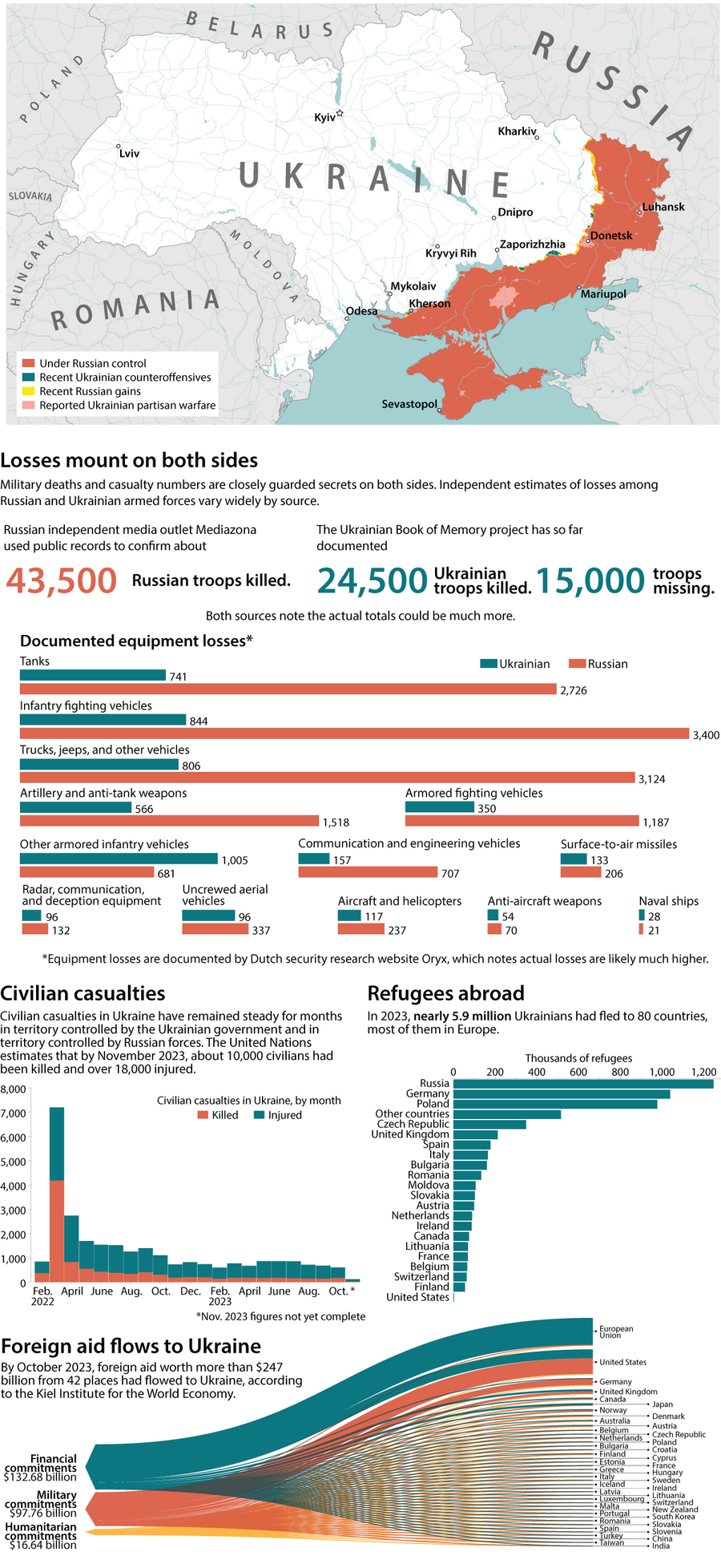
Kiel Institute, United Nations, Institute for the Study of War, Mediazona, Reuters, Oryx
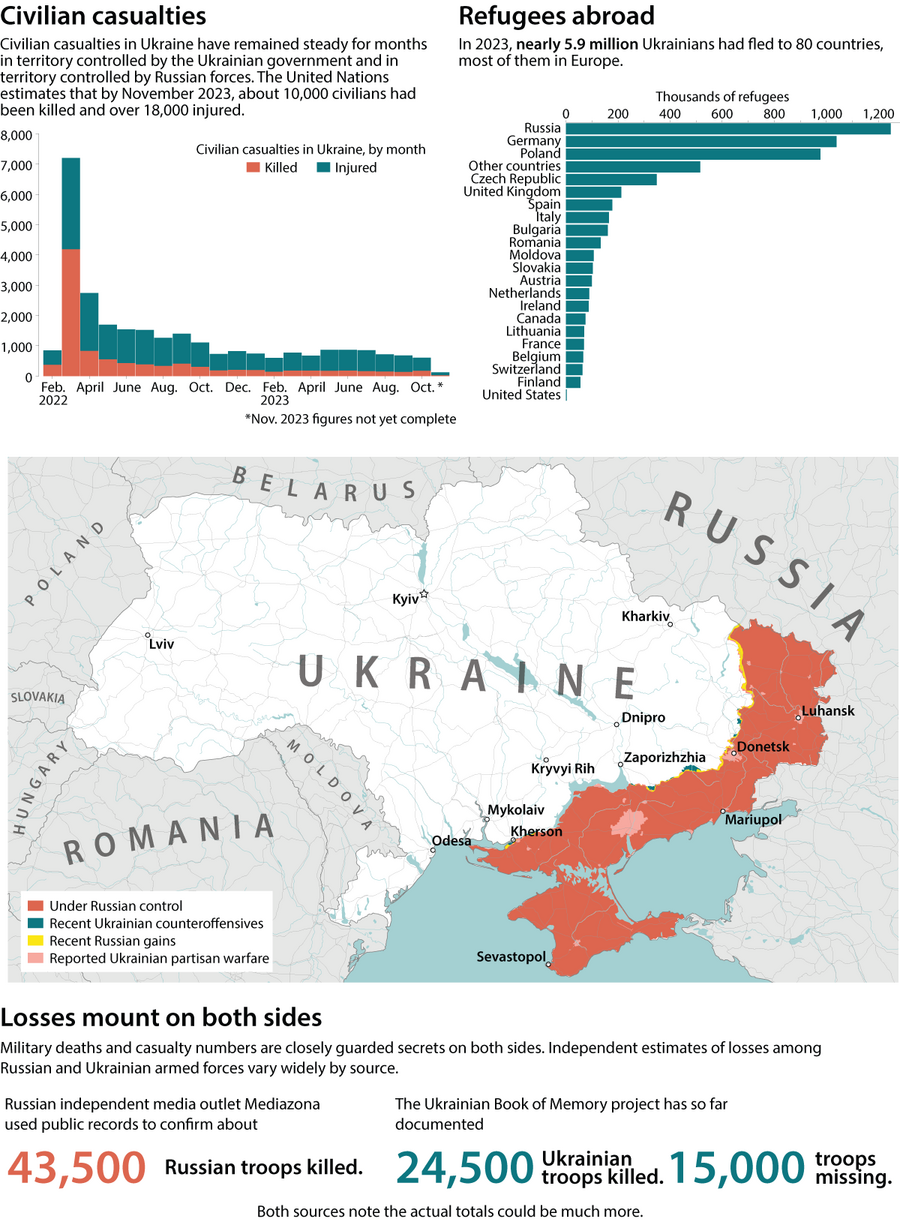
United Nations, Institute for the Study of War, Mediazona, Reuters

Why Haley focuses on her long game
Polls suggest that Nikki Haley has little hope of pulling off a primary win in her home state. At present, Donald Trump’s sway over the Republican party is too large. But she is taking a longer view.

- Quick Read
- Deep Read ( 6 Min. )
Presidential candidate Nikki Haley faces the prospect of a resounding defeat in her home state of South Carolina, where polls show her trailing former President Donald Trump by 20 points or more. Nevertheless, she’s already shrugging it off, insisting she’s in the race for the long haul.
“Dropping out would be the easy route,” the former South Carolina governor said in a recent campaign speech, noting that another 21 states and territories will vote over the next 10 days. “I’ve never taken the easy route.”
And in this highly unusual and unpredictable campaign season, some say Ms. Haley actually has good reasons to keep her candidacy going. They range from a controversial front-runner whose legal woes present a potential threat to his campaign, to Ms. Haley’s success in raising money, to a political environment in which many voters say they’re hungry for candidates other than the two major-party front-runners.
“Political rules hit the fan as soon as Donald Trump got into the race,” says Dave Wilson, a South Carolina GOP strategist. “If you’re the backup quarterback and something happens, guess who the coach is going to put into the game?”
Why Haley focuses on her long game
At a series of campaign stops for Nikki Haley ahead of Saturday’s South Carolina primary, voters gush about the Republican presidential hopeful. They praise her foreign policy experience and her calm demeanor in handling former President Donald Trump’s attacks. They point out approvingly that she’s not an octogenarian. They say it’s past time the United States elected its first female president.
What they do not say, however, is that they believe Ms. Haley can win.
“I don’t know that anyone thinks she’s going to win the state,” says Bev Denny, a campaign volunteer wearing various NIKKI stickers and pins, as she waits to see Ms. Haley speak in a park in Irmo. “[But] she doesn’t have to win our state to continue running.”
In a normal presidential election cycle, this would probably be a campaign declared dead. Ms. Haley came in third in Iowa, lost by double digits to Mr. Trump in New Hampshire, and suffered an embarrassing symbolic defeat in Nevada’s primary, where she came in second behind “None of these candidates.” (Mr. Trump was not on the ballot, running instead in the state’s GOP caucus.)
Now the South Carolina native, who served in the state Legislature and was twice elected governor, is facing the prospect of a resounding defeat in her home state, where polls show her trailing Mr. Trump by 20 to 40 points. Nevertheless, she’s already shrugging it off, insisting she’s in the race for the long haul.
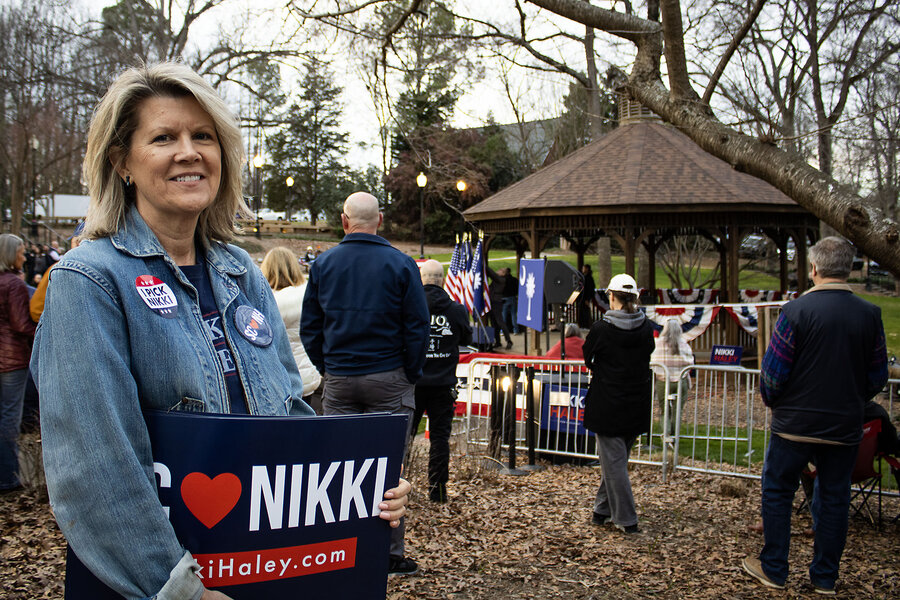
“Dropping out would be the easy route,” the former ambassador to the United Nations said in a recent campaign speech, noting that another 21 states and territories will vote over the next 10 days. “I’ve never taken the easy route.”
And in this highly unusual and unpredictable campaign season, some say Ms. Haley actually has good reasons to keep her candidacy going. They range from a controversial front-runner whose legal woes present a potential threat to his campaign, to Ms. Haley’s success in raising money, to a political environment in which many voters say they’re hungry for candidates other than the two major-party front-runners.
“Political rules hit the fan as soon as Donald Trump got into the race,” says Dave Wilson, a South Carolina GOP strategist. “If you’re the backup quarterback and something happens, guess who the coach is going to put into the game?”
The most obvious reason for Ms. Haley to keep running is Mr. Trump’s legal situation. The former president is facing 91 criminal counts in multiple jurisdictions, with his first criminal trial scheduled to start next month in New York. Recent civil suits against him have already resulted in awards of more than $400 million, a serious blow to his personal finances. And lawyers’ fees are absorbing more and more of his campaign cash.
So far, Mr. Trump’s legal woes have generally worked to his advantage with Republican primary voters, many of whom believe he is being treated unfairly. But polls also indicate that a small but consistent percentage would be less likely to support him were he to be convicted. And even Mr. Trump’s staunchest defenders might have second thoughts about his ability to win the general election in the wake of a criminal conviction.
Given all the “what ifs,” many Haley supporters agree she’d be foolish to end her bid before a win became mathematically impossible. Even after that, they say, the party may need a Plan B.
“I still think something is going to happen where Trump is not going to be able to run,” says Greg Ayers, a financial adviser in Rock Hill, as he waits to hear Ms. Haley speak in a ballroom near his home.

Financially, Ms. Haley has more than enough resources to hang around for a while. Her campaign brought in $9.8 million in contributions in January, $1 million more than Mr. Trump’s (though her campaign cash on hand is still less than half of his).
“As long as there are donors who are willing to put gas in the tank of Nikki Haley, she is going to keep going,” says Mr. Wilson. “Politics today is a money game.”
Many of those donors are establishment Republicans and independent voters who dislike both Mr. Trump and President Joe Biden – an environment that some observers suggest could create an opening for a third-party run.
Ms. Haley has flatly ruled out running on a third-party ticket, and many states have “sore loser laws” that prevent a failed primary candidate from mounting such a bid. But she might find herself tempted once the GOP nomination window formally closes, if voters are still clamoring for another choice.
More realistically, strategists say, Ms. Haley is probably thinking about 2028. If Mr. Trump wins the GOP nomination this year and then loses the White House again, Republican voters may start looking for the kind of political reset that Ms. Haley has been pitching – and would be positioned to lead.
Lately on the campaign trail, Ms. Haley has leaned into attacking Mr. Trump in ways she previously had avoided.
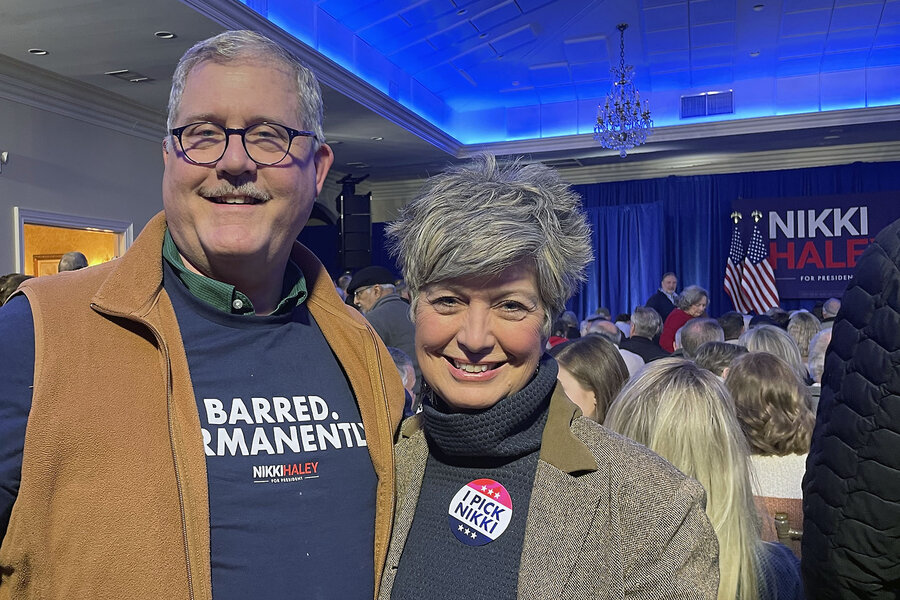
In Rock Hill, she criticized the former president for using campaign contributions to pay for his personal legal bills (to boos from the crowd). Outside a retirement community in Fort Mill, she told supporters that Mr. Trump would fail to protect the “success story” that is NATO and would “side with a thug who kills his political opponents,” referring to Russian President Vladimir Putin’s alleged killing of dissident Alexei Navalny. Speaking to several hundred voters in Irmo, Ms. Haley reminded them of Mr. Trump’s record at the ballot box, saying, “Everything he touches, he loses.”
At every stop in South Carolina, a state with one of the highest shares of both active duty military and veterans, Ms. Haley brought up Mr. Trump’s disparaging comments about the whereabouts of her husband, Michael, who is currently deployed.
“She’s finally taking a stand on [Trump], and I hope it brings more undecideds to her,” says Maria, a two-time Trump voter and part-time medical tech from Fort Mill, who declined to give her last name. “But I wish she’d done it sooner.”
Others say they understand why Ms. Haley waited to attack the man so far ahead of her in the polls.
“There were so many people running in the early primary season. And, I mean, Chris Christie was [attacking Mr. Trump], and where did that get him?” says Jonathan Taylor, a Haley supporter from York, referring to the former New Jersey governor whose campaign never gained traction. “Whether she should have started earlier – I don’t know if it would have been heard. But now she’s a clear, singular voice.”
Despite the growing likelihood of a third Trump GOP nomination, Mr. Taylor credits Ms. Haley’s campaign with providing voters like him at least a glimmer of possibility – which, for now, is something.
“I’ve never been so discouraged in a political season in my life,” says Mr. Taylor. “I’ve voted Republican all my life, and I’m done with the Republican Party. Except she gives me hope.”

Podcast
For Harlem, can a renaissance remembered also be revived?
When our cultural commentator touched down in New York’s Harlem for a walking tour, he found the touchstones of Black history palpable, abundant, and inspiring. Reporting ahead of a major exhibition on Harlem’s 1920s renaissance, he joined our podcast to talk about the Harlem of today.

Often, understanding the “then” calls for exploring the “now.”
That’s what took Ken Makin, the Monitor’s cultural commentator, to New York’s 125th Street and the blocks around it on a “Soul of Harlem” walking tour in advance of an exhibition on the Harlem Renaissance, opening Feb. 25 at New York’s Metropolitan Museum of Art.
“I was able to take Harlem in,” Ken says on the Monitor’s “Why We Wrote This” podcast. The period around 1925, the focus of the Met show, represents a period of renewal, of self-respect, and of self-dependence among Black people. Ken says he picked up on how that agency endures today, and is celebrated in both the iconography of modern Harlem and its people.
“It’s just this great appreciation for Black excellence, Black resistance,” Ken says. “Just this essence that despite gentrification or crime or whatever adversity that Harlem will experience, there’s just always this sense that the people there will not just ... survive, but thrive.”
The tour’s evidence ran from reminders of urgent, radical politics to triumphant acts of artistry to culinary evidence of the Great Migration (Ken relished his encounter with a red velvet cake). Signs of cultural perseverance abounded. Ken recalls meeting a book vendor – Mississippi-born, son of an English teacher – who’d been forced to relocate several times for one reason or another.
“What made me hopeful is that he was still out there with those books,” Ken says. “It’s just this continuing sense of purpose with Harlem.” – Clayton Collins and Jingnan Peng
Find story links and a transcript here.
Finding the Soul of Harlem

Essay
Hygge season: Learning to winter like the Danes
When winter grinds on, do as the Danes do: Rather than resist, embrace and savor the season. It’s a counterintuitive lesson in slowing down and leaning in to the state you’re in.
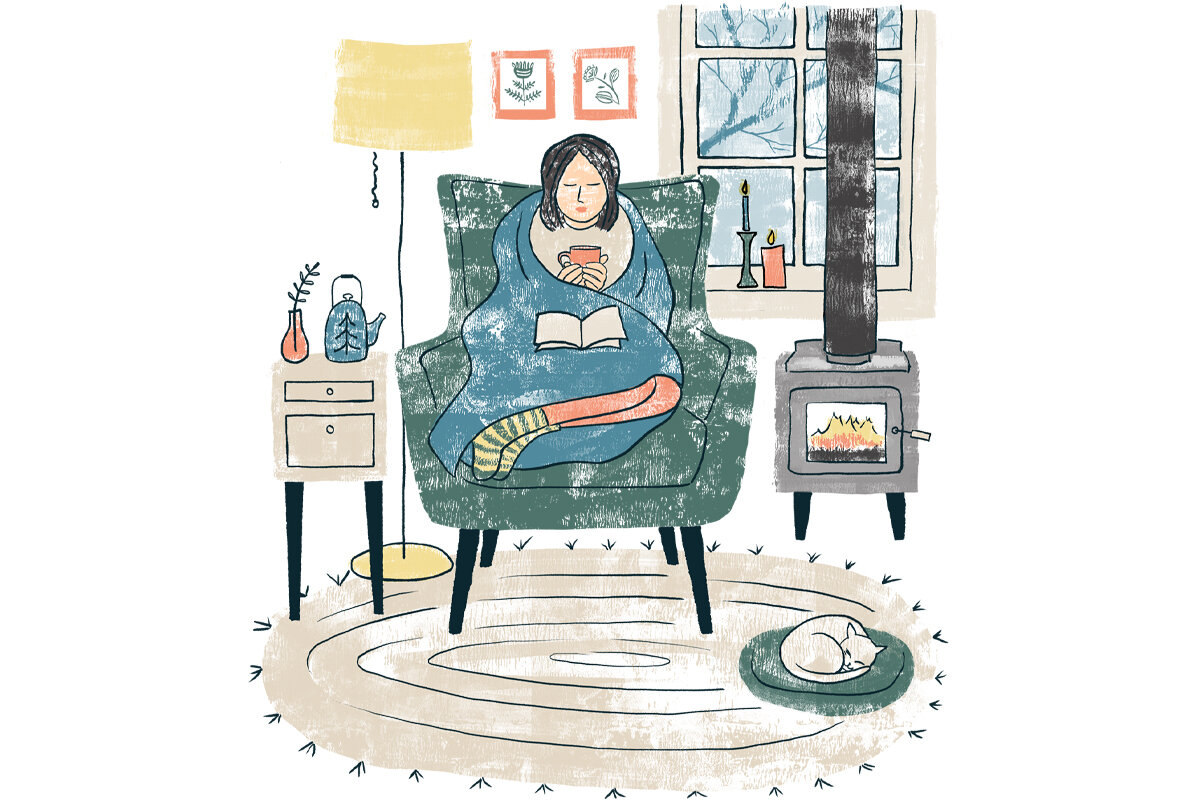
- Quick Read
- Deep Read ( 4 Min. )
-
By Samantha Laine Perfas Contributor
Picture this: You’re wrapped in a blanket, your cozy wool socks keeping your toes toasty, a cup of tea warming your palms. Candlelight flickers against the cabin wall as rain patters against the window.
This is the pinnacle of hygge.
The Danish concept (pronounced hoo-gah) rose to global consciousness when it made the shortlist for the Oxford Dictionaries’ 2016 Word of the Year. Its closest English relative is “coziness,” or warm and fuzzy feelings with hints of safety.
Meik Wiking, author of “The Little Book of Hygge,” and founder and CEO of the Happiness Research Institute in Copenhagen, has spent his professional life researching what makes people happy; in Denmark, hygge is a major driver.
“Denmark is by no means a perfect utopia,” Mr. Wiking writes in the book, “but I do believe Denmark can be a source of inspiration.”
Of course, hygge is about more than cozy socks and fluffy blankets. It’s about connecting to the moment.
As Mr. Wiking says, “[Scandinavian concepts like hygge] all place an importance on embracing the small pleasures which bring us happiness – the things which make life great.”
Hygge season: Learning to winter like the Danes
Picture this: You’re wrapped in a blanket, your cozy wool socks keeping your toes toasty, a cup of tea warming your palms. Candlelight flickers against the cabin wall as rain patters against the window.
This is the pinnacle of hygge.
The Danish concept (pronounced hoo-gah) rose to global consciousness when it made the shortlist for the Oxford Dictionaries’ 2016 Word of the Year. Its closest English relative is “coziness,” which conveys an intimate connection to warm and fuzzy feelings with hints of safety.
Meik Wiking, author of “The Little Book of Hygge,” and founder and CEO of the Happiness Research Institute in Copenhagen, has spent his professional life researching what makes people happy; in Denmark, hygge is a major driver.
“Denmark is by no means a perfect utopia,” Mr. Wiking writes in the book, “but I do believe Denmark can be a source of inspiration for how countries can increase the quality of life of their citizens.”
Denmark has some of the highest taxes in the world. But Mr. Wiking writes that most Danes are fine with it; it’s an investment in their society’s well-being that ensures the basic needs of its people are met. This frees up time and energy to spend on lots of things – including hygge.
“Hygge in Denmark is part of everyday life. It’s part of the culture and language; you are not aware of it until someone points it out,” Catarina Lachmund, a senior analyst at the Happiness Research Institute, told me in an email. She said that in Denmark, places strive to be described as hyggeligt (hoo-gah-lit), or having achieved ultimate levels of hygge.
When I first learned about hygge a few years back, it seemed to be the stuff of dreams. Even now, it feels out of reach in the United States, with its constant cultural pressure to have more and do more. Hygge, to me, seemed to be an invitation to slow down – and find peace doing so. I wanted that, if for no other reason than to gain that sense of calm in my fast-paced life.
Of course I could buy more candles; Mr. Wiking writes that more than 85% of Danes most associate hygge with candles. I could put on my hyggebukser (hoo-gah-buksr), that worn pair of sweatpants that should never be seen by another human. Or, I could do some renovating. According to the book, I just need to look around and ask myself: How would a Viking squirrel decorate this room?
And yet, if hygge is more than just things, and rather a way of life, perhaps there’s a way I can give myself a bit of a nudge to not just have hygge things, but to do hygge things.
Flipping through my options, I find my answer: Søndagshygge (Sun-das-hoo-gah), the word for hygge you have on Sundays. I laugh out loud. I can’t think of a better place to start.
In the U.S., many of us have a very different relationship with Sundays: the Sunday scaries.
This uniquely American phenomenon occurs on Sundays when your heart and mind fill with dread, realizing your weekend has come to a close and you have to reckon with Monday morning. In fact, a 2018 survey from LinkedIn found that nearly 80% of American adults – and over 90% of Gen Zers and millennials – worry about the upcoming week on Sundays.
And yet, the Danes don’t face the same sort of dread on a Sunday night.
“Experts tell you to pack your Sunday with getting ready for Monday to make Monday easier,” says Stephanie Pedersen, Danish American author of “American Cozy: Hygge-Inspired Ways To Create Comfort & Happiness.” “A Dane would really never do that. ... Work is going to be there tomorrow. So there’s no reason to bring it into today.”
I’ve often felt that dread creep into my Sundays. I asked Ms. Pedersen what she would do if she needed to reclaim her Sundays, in the name of hygge.
“De-clutter,” she says unequivocally. “And I’m not just talking about de-cluttering your bedroom or your pantry closet.” She suggests taking a hard look at all aspects of our lives, everything from our Google Calendars to our kids’ schedules to the number of people on our holiday card list. Americans have this knee-jerk reaction to do it all, she explains, but there’s value to creating space.
I’ve started to take her advice and have already noticed a change. No more cleaning on Sundays. Even when that dust bunny hops across the floor, I let it be until Monday. On Sundays, our calendar stays clear. When my thoughts start to creep to the work tasks awaiting me on Monday morning, I say, “Nope! My thoughts are for me and my people today.”
One recent Sunday, I sat with my 2-year-old son as he played. I took in his look of concentration, focused intently on his wooden train set. I noticed that his baby-soft locks have given way to little-boy hair. I scooched over to him, gave him a hug, and kissed his plump little cheek. I felt no need to rush off and fill the day with a thousand tasks. This was all that Søndagshygge asked of me: to be present for the ones I love.
“[Scandinavian concepts like hygge] all place an importance on embracing the small pleasures which bring us happiness – the things which make life great. Like being together – it’s about intimacy,” Mr. Wiking says in an email.
Hygge is about more than cozy socks and fluffy blankets. It can be found at a summer barbecue, on the beach reading a good book with your toes in the sand, or in the kitchen making fresh bread simply to give it a try. Hygge is about connecting to the moment and can be embraced anywhere, regardless of the backdrop. While accessories may amplify a hyggeligt moment of calm, they don’t have the power to create it. We have to create space for that ourselves.
“Stuff doesn’t anchor you,” Ms. Pedersen says. “Intention does.”
Other headline stories we’re watching
(Get live updates throughout the day.)The Monitor's View
Urban art as city corrective
- Quick Read
- Deep Read ( 2 Min. )
-
By the Monitor's Editorial Board
Recent drone shots high above Los Angeles have captured provocative images of a building that a movie director might someday find a way to monetize. The images show a long-abandoned, 27-story skyscraper with much of its exterior covered in colorful graffiti.
Is it beautifully crafted art or an eyesore left by vandals?
Some photographers gave attention to it because they believe someone took an ugly building and made it pretty. Meanwhile, Los Angeles City Council member Kevin de León said the city should not be an open canvas for any budding artists.
Such “creative place-making” as public art is sometimes called – even if done illegally – is often allowed by cities. It comfortably coexists with art in museums. Finding a balance between the two has become essential in urban areas. Philadelphia, in particular, offers an example of how public art has grown in acceptance, especially when it uplifts neighborhoods.
“There is no shortage of good ideas and excellent practitioners already present and active in Philadelphia, addressing pressing concerns of safety, health, and education through creative place-making,” stated Andrew Zitcer, a professor in the Westphal College of Media Arts & Design at Drexel University.
Urban art as city corrective
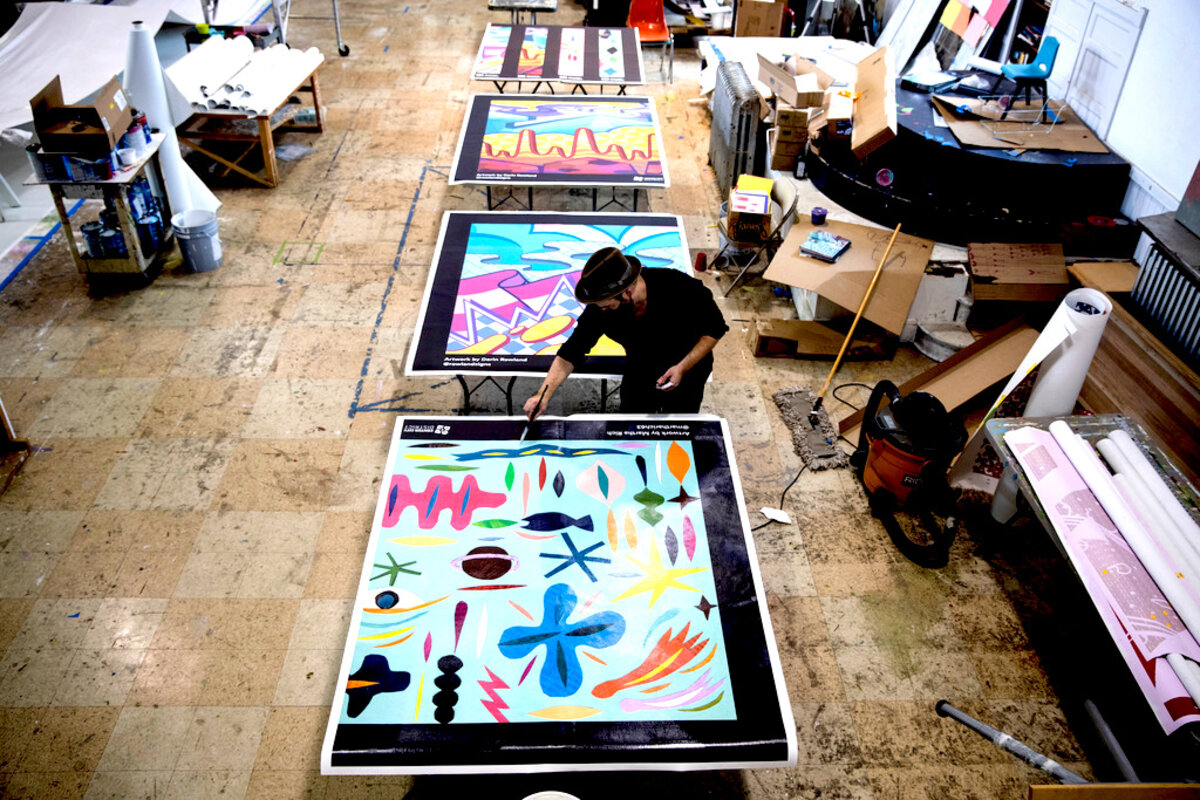
Recent drone shots high above Los Angeles have captured new and provocative images of a building that a movie director might someday find a way to monetize. The images show a long-abandoned, 27-story skyscraper with much of its exterior covered in colorful graffiti.
Is it beautifully crafted art or an eyesore left by vandals?
Some photographers gave attention to it because they believe someone took an ugly building and made it pretty. Meanwhile, Los Angeles City Council member Kevin de León said the city should not be an open canvas for any budding artists.
Such “creative place-making” as public art is sometimes called – even if done illegally – is often allowed by cities. It comfortably coexists with art in museums. Finding a balance between the two has become essential in urban areas. Philadelphia, in particular, offers an example of how public art has grown in acceptance, especially when it uplifts neighborhoods.
For more than 40 years, the Mural Arts Philadelphia program in the city has transformed blighted areas into wondrous public spaces. It started as the Anti-Graffiti Network to combat entropic acts of vandalism via graffiti and turn them into permanent art with endless canvases. It has grown to include initiatives such as the Restorative Justice program, which is centered around reentry for formerly incarcerated people and can include part-time employment. There is also the environmental justice program, which builds and restores green space.
Another organization, The Village of Arts and Humanities, has been transforming blocks in north Philadelphia with creations to support artists and Black residents in imagining a more just society. In 2021, as part of an exhibit entitled “Staying Power,” artists displayed larger-than-life photographs of five local women who had been released from prison after serving decades behind bars.
The People’s Paper Co-op was started in 2014 as an arts workshop to help individuals get existing criminal records expunged. People whose records were expunged turned their paper versions into pulp, made new paper, and wrote down what their future lives might look like. A more recent effort, called “Village Oracle,” allowed 14 Black artists to display their art on construction fencing.
“There is no shortage of good ideas and excellent practitioners already present and active in Philadelphia, addressing pressing concerns of safety, health, and education through creative place-making,” wrote Andrew Zitcer, a professor in the Westphal College of Media Arts & Design at Drexel University, in The Philadelphia Inquirer in 2021.
When a city such as Philadelphia – or Los Angeles – experiences high levels of violence, drug use, and homelessness, many residents can’t leave. Yet they keep living, which also means imagining the best version of themselves. Public art allows people to encounter beauty and ingenuity for themselves and others. That aesthetic contribution in places where they live can’t be ignored. A newly decorated skyscraper in LA helps explains why.

A Christian Science Perspective
Each weekday, the Monitor includes one clearly labeled religious article offering spiritual insight on contemporary issues, including the news. The publication – in its various forms – is produced for anyone who cares about the progress of the human endeavor around the world and seeks news reported with compassion, intelligence, and an essentially constructive lens. For many, that caring has religious roots. For many, it does not. The Monitor has always embraced both audiences. The Monitor is owned by a church – The First Church of Christ, Scientist, in Boston – whose founder was concerned with both the state of the world and the quality of available news.
You’re somebody special
- Quick Read
- Read or Listen ( 3 Min. )
-
By Laura Lapointe
We all have innate and unique worth as God’s children, reflecting His beautiful and good nature.
You’re somebody special
My favorite shirt when I was little said in bright sparkly letters, “I’m somebody special.” I kept it long after it no longer fit me because knowing it was there felt comforting.
At one point in later years, I said in an exasperated tone to my boyfriend at the time, “I want to feel special!” I guess I was hinting that some sort of gift from him would help with that. He showed up a few days later with some chocolate that had been on sale at a local market. To signify the marked-down price, there was a red sticker on it that read “special” in cursive. While the gesture was endearing and briefly made me smile, it didn’t resolve the feeling that I wasn’t special.
At the time, I was struggling with feeling unsuccessful and comparing myself to others who seemed to be doing much better in many aspects of their lives. I realized that it was going to take more than a sparkly shirt or a gift to heal the void I felt.
I had learned through Christian Science that each of us is part of God’s good and beautiful creation. So I sought encouragement in that idea. Christian Science also teaches that our true identity and value are found not in material circumstance, but in spiritual substance.
In Psalms, the Bible describes us as God’s masterpieces: “I praise you because of the wonderful way you created me. Everything you do is marvelous!” (139:14, Contemporary English Version). Since God is Spirit, this marvelous creation described here would not be made of material elements – it would be entirely spiritual. What makes us wonderful must be spiritual qualities.
Those qualities can seem sort of abstract. It might be easier to see oneself as a person with certain physical or emotional characteristics than to see oneself as composed of things like integrity, patience, and strength. But these qualities are actually so much more substantial and reliable than a set of traits that could change based on circumstances. What truly makes us marvelous is more our innate ability to express compassion toward others, for instance, than a cool haircut or skill at planning parties – though those types of things can hint at these deeper aspects of who we are.
As I prayed about all this, I began to see that being spiritual means we are free from the limitations of matter. Recognizing this gives us a higher and more meaningful sense of our worth and uniqueness. It enhances our concept of our identity in ways that improve our mental as well as physical well-being. Mary Baker Eddy, the discoverer of Christian Science, writes, “The individuality of man is no less tangible because it is spiritual and because his life is not at the mercy of matter. The understanding of his spiritual individuality makes man more real, more formidable in truth, and enables him to conquer sin, disease, and death” (“Science and Health with Key to the Scriptures,” p. 317).
I also reminded myself that this applies not just to me, but to everyone. It was helpful to move my focus off of myself and take note of the substantial qualities others were expressing. At the time, I was working in a prison with young men who had been labeled as high risk for recidivism. But considering things from a spiritual view, I could readily see their kindness, resilience, and dedication to something good despite these confining societal labels. Some of them went on to contribute meaningfully to their communities upon their release.
One of these former inmates told me how much he appreciated my efforts to always treat them with respect and to see their inherent dignity. And ultimately I found myself feeling more satisfied and at peace with who I am – recognizing that my worth is not dependent on others’ opinions or my circumstances at a given time.
There are still moments when I wish I could just put on a “somebody special” shirt. But I find great comfort in reminding myself of Psalm 139’s message that everything God does is marvelous. We can’t stop being God’s wonderful children, and we’re all inherently capable of knowing, feeling, and living this. Unlike some chocolate that is temporarily on sale, each of us is divinely labeled with a spiritual “sticker” representing how perpetually unique and precious we are. We might outgrow a shirt or a situation, but we can never outgrow that sense of being truly, deeply special.

Viewfinder
Earth in the rearview

A look ahead
Thank you for joining us this week. We wish you all a wonderful weekend. On Monday, we’ll come back with a story from Ken Makin about Robert Smalls, a man whose historical legacy echoes Harriet Tubman’s but is often overlooked. We’ll also look at the challenges faced by Israeli women during the war.
Finally, we’re giving you a bonus read that connects with today’s Viewfinder image. A private company has landed a lunar spacecraft, marking America’s first return to the moon since the Apollo program. It points to a long-anticipated era in moon exploration and development. You can read the story here.



